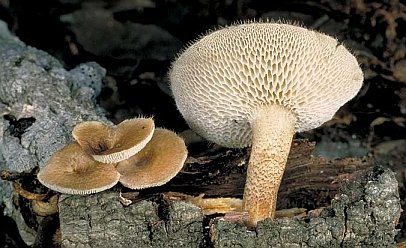The spring polypore, Polyporus arcularius (Batsch) Fr., characterized by the honey-colored cap, the cileate margin, and the large angular pores.
Synonyms
Boletus alveolarius Bosc
Boletus arcularius Batsch
Boletus exasperatus Schrad.
Favolus agariceus (Berk.) Lév.
Favolus alveolarius (Bosc) Fr.
Favolus ciliaris Mont., Annls Sci. Nat.
Favolus curtisii Berk.
Favolus hondurensis (Murrill) Sacc. & D. Sacc.
Favolus portoricensis (Murrill) Sacc. & D. Sacc.
Favolus squamiger Berk., J. Linn. Soc.
Heteroporus arcularius (Batsch) Lázaro Ibiza
Hexagonia hondurensis Murrill
Hexagonia portoricensis Murrill
Leucoporus agariceus (Berk.) Pat.
Leucoporus arcularius (Batsch) Quél.
Polyporellus agariceus (Berk.) Pilát
Polyporellus alveolarius (Bosc) P. Karst.,
Polyporus agariceus Berk.
Polyporus alveolarius (Bosc) Fr.
Polyporus anisoporus Delastre & Mont.
Polyporus arculariellus Murrill
Polyporus arculariformis Murrill
Polyporus calaber F. Brig.
Polyporus handelii Lohwag
Polyporus intermedius Rostk., in Sturm
Polyporus nanus Durieu & Mont.
Polyporus orbicularis Saut.
Polyporus penningtonii Speg.
Polyporus rhombiporus Pers.
Polyporus umbilicatus Jungh.
Polyporus vanderystii Lloyd
Common names
Fringed polypore
Spring polypore

My name is Austin Collins.
I've dedicated my life to Mushrooms.
I believe Mushrooms are the best kept secret when it comes to health and well being.
For that reason, I would like to share a company with you that in my opinion makes the best mushroom products on the market.
The company is called Noomadic Herbals, my favorite supplement they make is called "Mushroom Total".
I take their products every day and they have helped me think better and have more energy. Give them a try.
-Austin
Description
Fruiting body: circular, convex to umbilicate, 1-8 cm in diameter, 1-4 mm thick; depressed center, squamulose, hispid-tomentose or glabrous, cinnamon-buff to antimony-yellow when fresh, drying brown; margin acute, ciliate, straight, reflexed on drying; context white, drying white to pinkish-buff, 0.5-2 mm thick.
Tubes: decurrent, white to pinkish-buff, drying light pinkish-buff to tawny, 1-3 mm long; mouths large, angular or honeycomb-shaped, pores 1-2 per mm, concolorous with the tubes.
Stem: central or slightly off-center, slender, 2-4 cm long, 2-3 mm thick, squamulose, hispid–tomentose or glabrous above, fibrillose and bulbous at the base, concolorous with the pileus or slightly darker.
Spore print: white.
Spores: hyaline, smooth, elongate-ellipsoid, apiculate, nonamyloid, 7-11 x 2-3 µm.
Habitat: on various deciduous hosts, especially Populus tremuloides.
Occurrence: uncommon. Spring and early summer.
Edibility: edible but essentially unpalatable due to tough flesh.
This polypore causes a white rot on dead hardwoods.
Bioactive compounds
P. arcularius has been chemically investigated (Fleck et al., 1996) yielding isodrimenediol, drimenediol, and related sesquiterpenes. Later, two additional compounds, named isocryptoporic acids H (3-carboxy-2- (2,5,5,8a-tetramethyl- 1,4,4a,5,6,7,8,8a-octahydro-naphthalen-1-ylmethoxy) -pentanedioic acid) and isocryptoporic acid I (3-carboxy-2- (6-hydroxy-2,5,5,8a-tetramethyl-1,4,4a,5,6,7,8,8a- octahydro-naphthalen-1-ylmethoxy) -pentanedioic acid.), were isolated. These isocryptoporic acids are isomers of the cryptoporic acids with drimenol instead of albicanol as the terpenoid fragment (Cabrera et al., 2002).
Medicinal properties
Antibacterial activity
Both the aqueous and organic fractions from an extract of the mycelial culture of P. arcularius showed antibacterial activity against Escherichia coli, Salmonella typhimurium, Staphylococcus aureus and Bacillus subtilis (Yamac and Bilgili, 2006). Another group had previously reported antimicrobial activity in this species, but also noted some intra-specific genetic differences (Suay et al., 2004).
Polysaccharides extracted from the mycelial culture of P. arcularius and administered intraperitoneally into white mice at a dosage of 300 mg/kg inhibited the growth of Sarcoma 180 and Ehrlich solid cancers by 90% and 100%, respectively (Ohtsuka et al., 1973).
Links
Mushroom Expert
Australian Fungi Blog
Fungi on Wood website
References
Cabrera GM, Roberti MJ, Wright JE, Seldes AM.
Cryptoporic and isocryptoporic acids from the fungal cultures of Polyporus arcularius and P. ciliatus.
Phytochem. 2002 61(2):189-93.
Fleck WF, Schlegel B, Hoffmann P, Ritzau M, Heinze S, Grafe U.
Isolation of isodrimenediol, a possible intermediate of drimane biosynthesis from Polyporus arcularius.
J Nat Prod. 1996 59(8):780-1.
Ohtsuka S, Ueno S, Yoshikumi C, Hirose F, Ohmura Y, Wada T, Fujii T, Takahashi E.
Polysaccharides having an anticarcinogenic effect and a method of producing them from species of Basidiomycetes.
UK Patent 1331513, 26 September 1973.
Suay I, Arenal F, Asensio FJ, Basilio A, Cabello MA, Diez MT, Garcia JB, Val AG, Gorrochategui J, Hernandez P, Peláez F, Vicente MF.
Screening of Basidiomycetes for antimicrobial activities.
Antonie Van Leeuwenhoek. 2000 78: 129–139.
Yamac M, Bilgili F.
Antimicrobial activities of fruit bodies and/or mycelial cultures of some mushroom isolates.
Pharm Biol. 2006 44(9):660-7.



